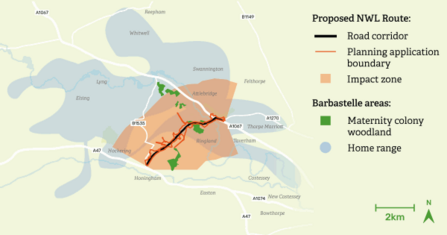Norfolk County Council will soon submit its planning application for the Norwich Western Link road. The coming spring will therefore be a vital time for us to speak up for the wildlife that depends on the tapestry of habitats threatened by the proposed route.
Our two most powerful tools in protecting wildlife are accurate data and work in partnership with other bodies and the community. A solid base of evidence is crucial to effective conservation, whether we are improving habitat for wildlife or protecting a vulnerable landscape for its wild inhabitants.
While the road will harm countless habitats and species, our research has focussed on the rare barbastelle bat, which is both legally protected and emblematic of the struggle to preserve the Wensum Valley. Growing evidence suggests that Norfolk holds vital strongholds for the barbastelle.
Building a case for the bats, we are working with Dr Charlotte Packman, an experienced conservation scientist who has studied barbastelles in Norfolk for over a decade. To understand the impact of a major road through the Wensum Valley, Dr Packman has researched two key questions: the presence and activity of barbastelles in habitats along the route; and the effectiveness of measures put in place for bats along the existing Northern Distributor Road.
Her findings are a stark warning to conservationists and developers alike, spotlighting the critical importance of Norfolk for this very rare bat and demonstrating that the Norwich Western Link would spell disaster for its survival. Dr Packman’s research has revealed the presence of many more barbastelles than Norfolk County Council ecologists have previously recorded, making the area even more important for the species.
Dr Packman’s data suggest a minimum of 105 barbastelles are present in one of the maternity colonies. Norfolk County Council’s ecologists recorded just 27 barbastelles in the same colony.
Her data also reveal the presence of a unique barbastelle super-colony in the area of the proposed road. The so-called super-colony comprises a number of large colonies of barbastelles and includes several woodlands supporting maternity colonies of vital importance to the survival of barbastelle bats in the UK.
Norfolk is home to the majority of known barbastelle maternity colonies, making us the guardians of this species in the UK.
Dr Packman’s data have also shown just how ineffective measures in place for bats along the existing NDR have been. This road development included structures known as bat bridges that, it was claimed, offered bats safe road crossings above vehicle height, from one area of habitat to another. Dr Packman’s data suggest that in fact barbastelles ignore these structures, preferring crossing points bordered by trees and overhanging vegetation, where they may be at risk from collision with vehicles. Alarmingly, her data suggest that barbastelle colonies present within 2.5km of the NDR prior to its construction have now disappeared.


